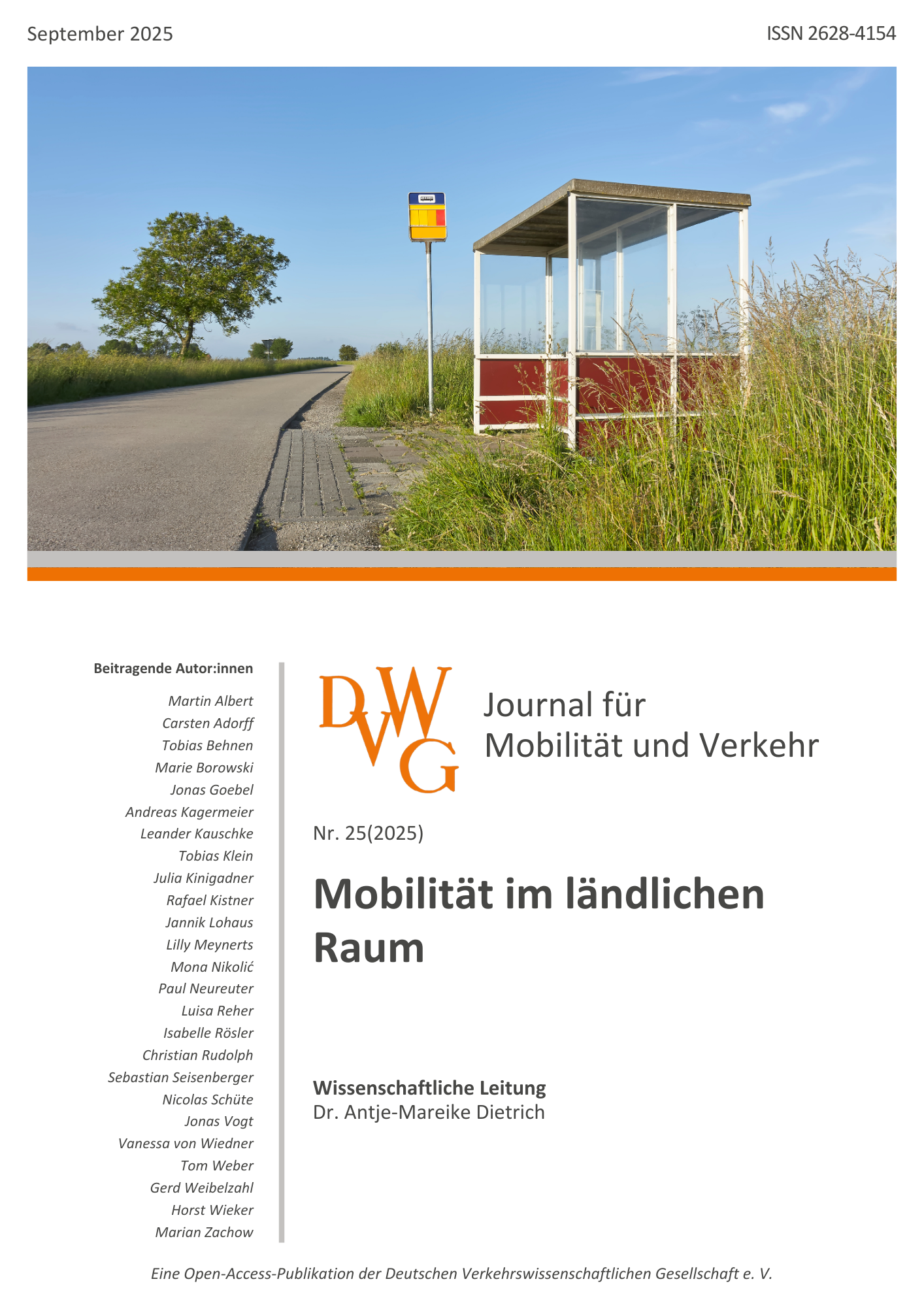Langzeitbewegungsprofile und Mobilitätsmotive: Ein hybrider Methodenansatz zur Mobilitätsentwicklung im ländlichen Raum.
DOI:
https://doi.org/10.34647/jmv.nr25.id223Schlagworte:
Mobilitätstagebuch, GPS Tracking, MaaS, Ländlicher Raum, Digitalisierung, On-Demand, SaarlandAbstract
Das Saarland hat die höchste Pkw-Dichte in Deutschland, gleichzeitig fehlte bislang eine solide Datengrundlage für die Förderung nachhaltiger Mobilität. Im Projekt INTE:GRATE wurden daher Wegeketten von rund 450 Saarländer*innen über ein halbes Jahr erhoben und ausgewertet. Ergänzt durch Fokusgruppen und Befragungen zeigt die Analyse, dass On-Demand-Dienste auch im ländlichen Bereich ein erhebliches Potenzial besitzen, den motorisierten Individualverkehr – insbesondere auf kurzen Strecken (aktuell bis zu 60 % MIV) – zu substituieren.
Literaturhinweise
Agriesti, S., Soe, R.M., Saif, M.A. (2022): Framework for connecting the mobility challenges in low density areas to smart mobility solutions: the case study of Estonian municipalities. European Transport Research Review, 14. https://doi.org/10.1186/s12544-022-00557-y
Alho, A., Cheng, C., Trung Hieu, D., Sakai, T., Zhao, F., Ben-Akiva, M., Cheah, L. (2022): Online and in-person activity logging using a smartphone-based travel, activity, and time-use survey. Transportation Research Interdisciplinary Perspectives 13. https://www.sciencedirect.com/science/article/pii/S2590198221002293
Alsaleh, N. (2022): Smartphone Travel Survey Tools, Laboratory of Innovation in Transportation, Toronto Metropolitan University.
Aspern mobil LAB: https://www.mobillab.wien/
Calastri, C., Crastes dit Sourd, R., Hess, S. (2020): We want it all: experiences from a survey seeking to capture social network structures, lifetime events and short-term travel and activity planning. Transportation 47, 175–201. https://doi.org/10.1007/s11116-018-9858-7
Casper, J., Otto, T. (2022): Die Verkehrskonzepte der Parteien zur Landtagswahl 2022 – Will das Saarland die Mobilitätswende? Aktuell – Themen-Service der Arbeitskammer des Saarlandes, Saarbrücken.
Chapin, F.S. (1974): Human activity patterns in the city: things people do in time and in space. Wiley, New York.
highQ mytraQ – Der perfekte Mobilitätsassistent: https://www.highq.de/
infas GmbH (2023): Mobilität in Deutschland – MiD Kurzbericht, https://www.mobilitaet-in-deutschland.de/pdf/MiD2023_Kurzbericht.pdf
infas GmbH (2023): Regionale Unterschiede – ein Überblick. https://www.mobilitaet-in-deutsch-land.de/pdf/MiD2023_Vortrag_regionaleErgebnisse.pdf
Kraftfahrt-Bundesamt (2025): Statistikportal Fahrzeugdichte, https://experience.arcgis.com/experience/fa9edaee4fca4b31a7711cbed6fba49c/page/Fahrzeuge?views=%2F-Personenkraftwagen
Küpper, Milbert (2020): Typen ländlicher Räume in Deutschland, Bonn, https://nbn-resolving.org/urn:nbn:de:0168-ssoar-71081-9
Lamnek, S., Krell, C. (2005): Qualitative Sozialforschung. Psychologie Verlags Union, München.
Li, J., Earnest, J. (2015): Das Beste aus zwei Welten: Vorteile einer Kombination von quantitativen und qualitativen Forschungsmethoden. WZB Mitteilung (150), Dezember.
motiontag: https://www.motiontag.com/de/
Nobis, C., Herget, M. (2020): Mobilität in ländlichen Räumen – Betrachtungen aus Sicht der Verkehrswende und der Gleichwertigkeit von Lebensverhältnissen. Internationales Verkehrswesen 72(4), 2–5.
Plazinić, B.R., Jović, J. (2018): Mobility and transport potential of elderly in differently accessible rural areas. Journal of Transport Geography 68, 169–180.
Sammer, G., Gruber, C. et al. (2018): The dilemma of systematic underreporting of travel behavior when conducting travel diary surveys – A meta-analysis and methodological considerations to solve the problem, Wien. https://www.sciencedirect.com/science/article/pii/S2352146518301571?via%3Dihub
Saarland - Ministerium für Wirtschaft, Arbeit, Energie und Verkehr, Abteilung D Verkehr (2021): Verkehrsentwicklungsplan ÖPNV (VEP ÖPNV) Saarland, https://www.saarland.de/SharedDocs/Downloads/DE/mukmav/verkehr/ÖPNV/dld_vep_oepnv_bericht.pdf?__blob=publicationFile&v=4
Sochor, J., Arby, H., Karlsson, I.C.M., Sarasini, S. (2018): A topological approach to Mobility as a Service: A proposed tool for understanding requirements and effects, and for aiding the integration of societal goals. Research in Transportation Business & Management, 27, 3–14.
Vitale Brovarone, E. (2022): Accessibility and mobility in peripheral areas: a national place-based policy. European Planning Studies 30(8), 1444–1463.
von Behren, S. (2017): Bringing travel behavior and attitudes together: An integrated survey approach for clustering urban mobility types. 97th Annual Meeting of the Transportation Research Board.
Winkler, C., Meister, A., Axhausen, K.W. (2024): The TimeUse+ data set: 4 weeks of time use and expenditure data based on GPS tracks. Journal Transportation.
Wolf, J., Guensler, R. (2001): Elimination of the Travel Diary: Experiment to Derive Trip Purpose from Global Positioning System Travel Data. Transportation Research Record: Journal of the Transportation Research Board 1768, Washington D.C.

Downloads
Veröffentlicht
Ausgabe
Rubrik
Lizenz
Copyright (c) 2025 Isabelle Rösler, Carsten Adorff, Leander Kauschke, Jonas Vogt, Horst Wieker

Dieses Werk steht unter der Lizenz Creative Commons Namensnennung - Nicht-kommerziell - Keine Bearbeitungen 4.0 International.

